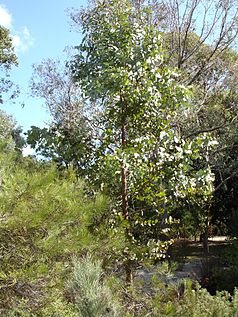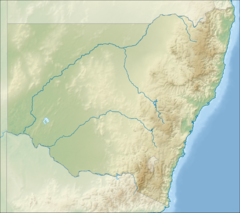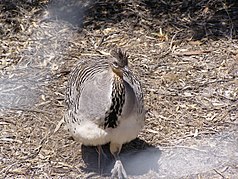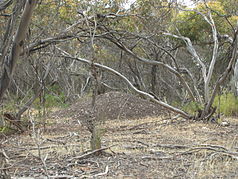Mallee Cliffs National Park
| Mallee Cliffs National Park | ||
|---|---|---|
| White Mallee | ||
|
|
||
| Location: | New South Wales , Australia | |
| Specialty: | Sand plains, sand dunes, mallee eucalyptus, thermometer chicken | |
| Next city: | Mildura | |
| Surface: | 580 km² | |
| Founding: | April 22, 1977 | |
| Map of the Mallee Cliffs National Park | ||
| Thermometer chicken | ||
| Nest of a thermometer chicken | ||
| Bluetongue skink | ||
The Mallee Cliffs National Park is a national park in the southwest of the Australian state of New South Wales , 789 kilometers west of Sydney and 30 kilometers north of the Murray River near Mildura . The park was created to preserve the sands, sand dunes and habitats of the Mallee Country . Special emphasis is placed on the role of the park as a wildlife sanctuary and its facility should primarily protect the habitat of the thermometer chicken (Leipoa ocellata).
The park is not open to the public because they want to protect the thermometer chicken and other threatened species and to achieve other conservation goals. Access is only available to schools and colleges for educational purposes and for scientific studies that are important for the park administration and are compatible with the protection principles.
The national park was established in 1977 on an area of 57,969 hectares after the Foundation for National Parks & Wildlife bought the entire site privately.
geography
Mallee Cliffs National Park preserves the original red clay plains in southwest New South Wales and protects the extensive flat to gently undulating red sand plains and linear sand dunes that were formed in the dry seasons 350,000 - 500,000 years ago.
flora
Original clusters of mallee trees and loose rosewood belah forest are preserved in the park . Mallee are small eucalyptus trees and bushes with many small trunks and thick roots that can hold water. Before irrigated agriculture began, mallee thickets covered most of northwestern Victoria and areas in southwestern New South Wales. The park contains important mallee societies, including the Bull Mallee and Whipstick Mallee varieties . This vegetation continues to be extensively cleared across the country outside the park in order to gain grazing land. Relics of plant communities survive in the park, which can make long-term changes in the vegetation visible.
In January 1975, a forest fire destroyed the area that later became a national park, making the average age of the plants significantly lower than in similar protected areas. This makes the park less attractive to the release of certain animals, such as the honey-eater species Black-eared Miner , who use older mallee trees and bushes for habitat.
fauna
The park is the only thermometer hen sanctuary in New South Wales. This bird is only found in arid areas where mallee grows. The roosters build a nest by digging a large hole in winter and filling it with grass and leaves for four months. The chickens lay one egg a day in this nest for a few days in the spring. The taps then cover the whole thing with sand. This “compost” then rots and develops heat. The roosters monitor the nest, check its temperature with their tongues and remove or add sand as needed. When the chicks hatch, they dig their way to the surface and stay there for up to 20 minutes before they head off into the undergrowth. The chicks hatch with feathers and are immediately independent of the adult birds. They do not need brood care. The thermometer chicken is up to 60 cm long.
There are also a number of smaller bird species in the area, as well as emus . In terms of mammals, there are the western gray giant kangaroo , the bilchbeutler and two bat species ( Little Pied Bat and Greater Long-eared Bat ) that use old trees as nests. The mallee (spinifex) is the main habitat for the bluetongue .
Web links
Individual evidence
- ↑ a b c Mallee Cliffs National Park - Fire Management Plan . NSW Environment & Heritage Office ( Memento of the original from March 20, 2011 in the Internet Archive ) Info: The archive link was inserted automatically and has not yet been checked. Please check the original and archive link according to the instructions and then remove this notice. (PDF; 3.9 MB)
- ^ Mallee Cliffs National Park - Plan of Management . NSW Environment & Heritage Office (PDF; 80 kB)
- ↑ a b Mallee Cliffs National Park . NSW Environment & Heritage Office
- ↑ a b Mallee Cliffs National Park . Foundation for National Parks & Wildlife ( Memento of the original from March 4, 2010 in the Internet Archive ) Info: The archive link was inserted automatically and has not yet been checked. Please check the original and archive link according to the instructions and then remove this notice.
- ↑ National recovery plan for the Black-eared Miner Manorina melanotis 2002 - 2006 . Australian Government, Department of the Environment, Water, Heritage and the Arts
- ↑ More about the Mallee Fowl . The Victorian Malleefowl Recovery Group, Inc. ( Memento of the original from February 10, 2004 in the Internet Archive ) Info: The archive link was automatically inserted and not yet checked. Please check the original and archive link according to the instructions and then remove this notice.
- ↑ Mallee Slender Blue-tongue Lizard - Endangered Species Listing . NSW Environment & Heritage Office





